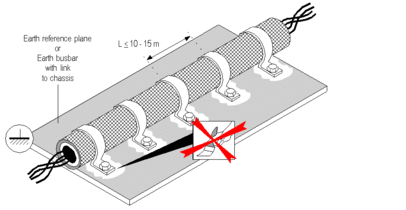Guidelines for selecting the method of connection
The table shows how the cable shield should be connected to ground depending on the application:
Application |
Cable shield ground connection |
|---|---|
Shielded analog measuring circuit in the cabinet |
|
Shielded analog measuring circuits outside of cabinets in closed buildings |
|
Long lines
For long shielded lines, several ground connections at intervals of 10 ... 15 m along the length of the cable are recommended:

Characteristics of the connection methods
The shielding ground connection is very important for the shielding effectiveness. The following ground connection options have differing effectiveness:
Cable shield ground connection |
Effectiveness and advantages |
Restrictions |
|---|---|---|
Ground connection on both ends of the cable Extremely effective |
|
|
Ground connection on only one end of the cable Average shielding effectiveness |
|
|
Shielding without ground connection Not recommended |
|
|


